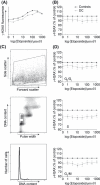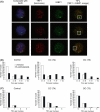Dyskeratosis congenita and the DNA damage response
- PMID: 21477209
- PMCID: PMC3328754
- DOI: 10.1111/j.1365-2141.2011.08679.x
Dyskeratosis congenita and the DNA damage response
Abstract
Dyskeratosis congenita (DC) is a heterogeneous bone marrow failure disorder with known mutations in components of telomerase and telomere shelterin. Recent work in a mouse model with a dyskerin mutation has implicated an increased DNA damage response as part of the cellular pathology, while mouse models with Terc and Tert mutations displayed a normal response. To clarify how these contradictory results might apply to DC pathology in humans, we studied the cellular phenotype in primary cells from DC patients of several genetic subtypes, focussing on T lymphocytes to remain close to the haematopoietic system. We observed novel cell cycle abnormalities in conjunction with impaired growth and an increase in apoptosis. Using flow cytometry and confocal microscopy we examined induction of the DNA damage proteins γ-H2AX and 53BP1 and the cell cycle protein TP53 (p53). We found an increase in damage foci at telomeres in lymphocytes and an increase in the basal level of DNA damage in fibroblasts, but crucially no increased response to DNA damaging agents in either cell type. As the response to induced DNA damage was normal and levels of global DNA damage were inconsistent between cell types, DNA damage may contribute differently to the pathology in different tissues.
© 2011 Blackwell Publishing Ltd.
Figures







References
-
- d'Adda di Fagagna F, Reaper PM, Clay-Farrace L, Fiegler H, Carr P, Von Zglinicki T, Saretzki G, Carter NP, Jackson SP. A DNA damage checkpoint response in telomere-initiated senescence. Nature. 2003;426:194–198. - PubMed
-
- Armanios M, Chen JL, Chang YP, Brodsky RA, Hawkins A, Griffin CA, Eshleman JR, Cohen AR, Chakravarti A, Hamosh A, Greider CW. Haploinsufficiency of telomerase reverse transcriptase leads to anticipation in autosomal dominant dyskeratosis congenita. Proceedings of the National Academy of Sciences of the United States of America. 2005;102:15960–15964. - PMC - PubMed
-
- Auerbach AD. Fanconi anemia diagnosis and the diepoxybutane (DEB) test. Experimental Hematology. 1993;21:731–733. - PubMed
Publication types
MeSH terms
Substances
Grants and funding
LinkOut - more resources
Full Text Sources
Research Materials
Miscellaneous

